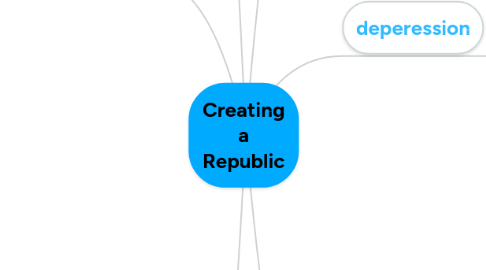
1. the articles of confederation
1.1. strengths
1.1.1. coin money
1.1.2. appoint military officers
1.1.3. deal with foreign affairs
1.1.4. declare war
1.2. ideas
1.2.1. run nation as a whole
1.2.2. 1 branch of gov.
1.2.3. each state 1 vote
1.2.4. 9/13 approve
1.3. weaknesses
1.3.1. states weren't willing to give up power. they feared a repeat of British tyranny.
1.3.2. congress's power was limited
1.3.2.1. no regulation of trade
1.3.2.2. no ability to tax
1.3.2.3. to one to make sure laws were followed
1.3.2.4. no power to solve conflicts between states
1.3.2.5. other countries could take land easily
2. settling new lands
2.1. settled west of Ohio river
2.2. Land Ordinance of 1785
2.2.1. System of settling the northwest territory
2.2.2. Present day states of Ohio, Illinois, Michigan, and Wisconsin
2.2.3. Within each township, one section was set aside for $640.
2.3. Northwest Ordinance of 1787
2.3.1. Gave basic rights to settlers
2.3.2. Outlawed slavery
2.3.3. Population of 60,000 = new state could form
3. constitutional convention
3.1. gathering of state representatives
3.1.1. May 25, 1787
3.1.2. revised the AOC
3.2. 3 branches of gov.
3.2.1. legislative branch: passes laws
3.2.2. executive branch: carries out laws
3.2.3. judicial branch: decides if laws are carried out fairly
3.3. Virginia plan
3.3.1. called for a strong national government with 3 branches and a two-chamber legislature
3.3.2. James Madison: delegate from Virginia
3.4. New Jersey plan
3.4.1. favored by smaller states
3.4.2. 3 branches of government with a single-chamber legislature
3.5. three- fifths compromise: three-fifths of the slaves in any state be counted in its population
3.6. the great compromise
3.6.1. plan at the constitutional convention that settled the differences between large and small states
3.6.2. Roger Sherman: delegate from Connecticut
3.7. types of gov.
3.7.1. republic: a government in which citizens rule themselves through elected representatives
3.7.2. dictatorship: a government in which one person or a small group holds complete authority
3.7.2.1. a government in which one person or a small group holds complete authority
4. deperession
4.1. Shay's rebellion
4.1.1. Daniel shays= MA farmer
4.1.2. 1786
4.1.3. farms were taken because people couldn't pay loans
4.1.4. taxes raised
4.1.5. rebelled
4.1.5.1. attacked courthouses
4.1.5.2. angry farmers gathered
4.1.5.3. MA militia came and sent them away
4.2. Shay's rebellion showed the the AOC weren't working
4.3. called for a convention to revise the AOC
5. ideas behind the constitution
5.1. the enlightenment
5.1.1. john Locke and Two Treatises of Government
5.1.1.1. said that everyone has natural rights
5.1.1.2. the ruler must make the people to follow the laws and protect them
5.1.2. Baron de Montesquieu and The Spirit of the Laws
5.1.2.1. stressed the importance of law
5.1.2.2. suggested having 3 branches: judicial, executive, legislative
5.2. 2 basic rights of magna carta:
5.2.1. king george couldn't raise taxes without discussing about it with the great council
5.2.2. english nobles had certain rights
5.3. englsih bill of rights
5.3.1. it protected the rights of citizens
5.3.2. parliamentary elections held regularly
5.3.3. right to trial by jury
5.3.4. right to bear arms
5.3.5. right of habeas corpus
5.4. learned from the collapse of the Roman republic
6. the constitution and the Bill of Rights
6.1. federalists: supporters of the Constitution
6.1.1. thought that the Articles of Confederation gave too much power with the states
6.1.2. resulted in a weak central gov.
6.1.3. said that fighting among states made it hard to govern
6.1.4. constitution gave national gov. authority and protected state’s rights/powers
6.2. anti federalists: people who opposed the Constitution
6.2.1. thought that the Constitution made gov. too strong and states too weak
6.2.2. feared that the president would become someone like a king
6.3. federalist papers
6.3.1. written by John Jay, Alexander Hamilton, and James Madison
6.3.2. is a series of essays
6.3.3. explained and defended the Constitution
6.4. Bill of Rights
6.4.1. anti federalists wanted it to protect basic rights
6.4.2. George Mason of Virginia wrote the bill of rights in 1776 but got rejected then joined the anti federalists
6.4.3. federalists said that the Constitution protected people already
6.4.4. anti federalists said that it was easy to ignore if it wasn’t written out
6.4.5. james madison wrote 12 amendments, and 10 were ratified by the states. 1791. the 10 amendments became Bill of Rights
6.5. ratification
6.5.1. new England states voted first
6.5.2. NH became 9th state, which meant that the the plan would go in affect
6.5.3. virginia finally voted when federalists agreed to include a bill of rights
6.5.4. all the states ratified by 1790

